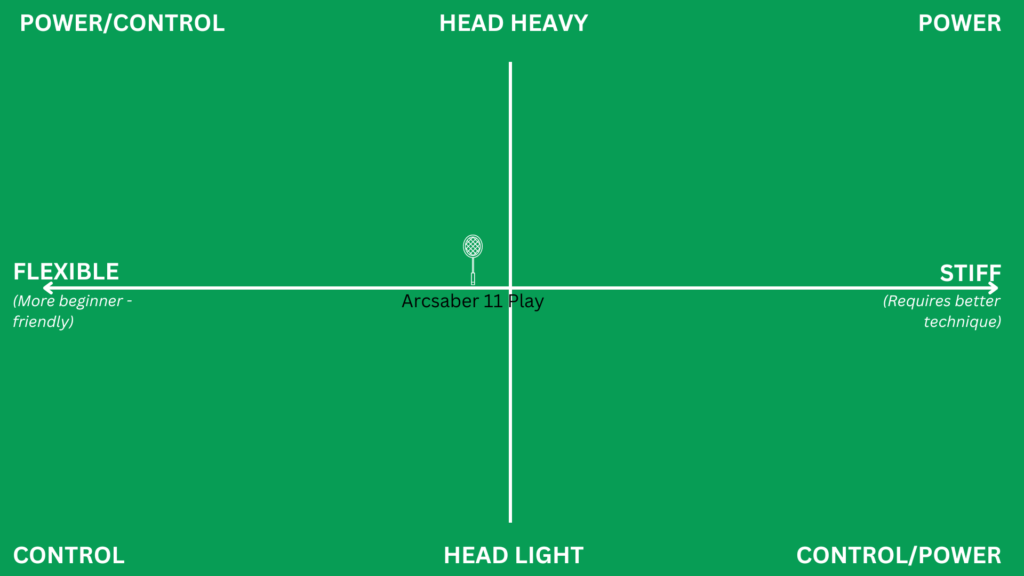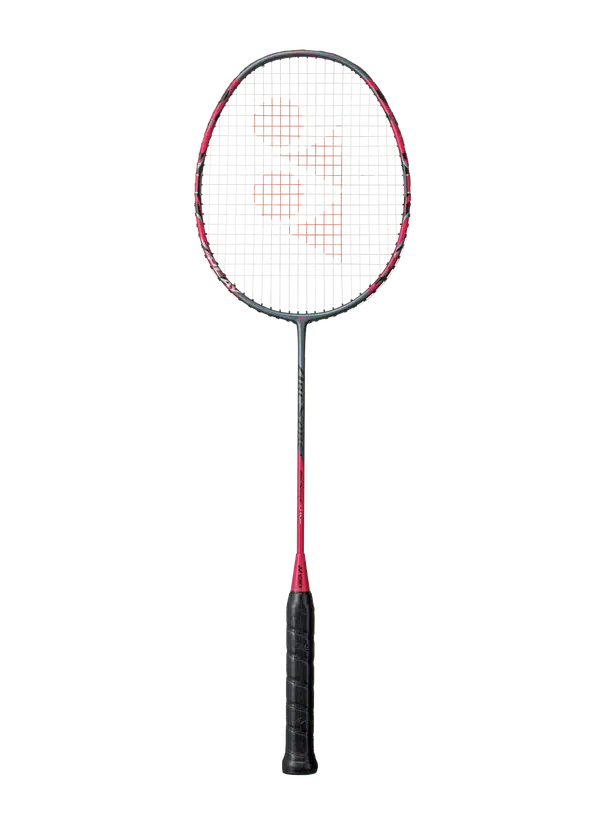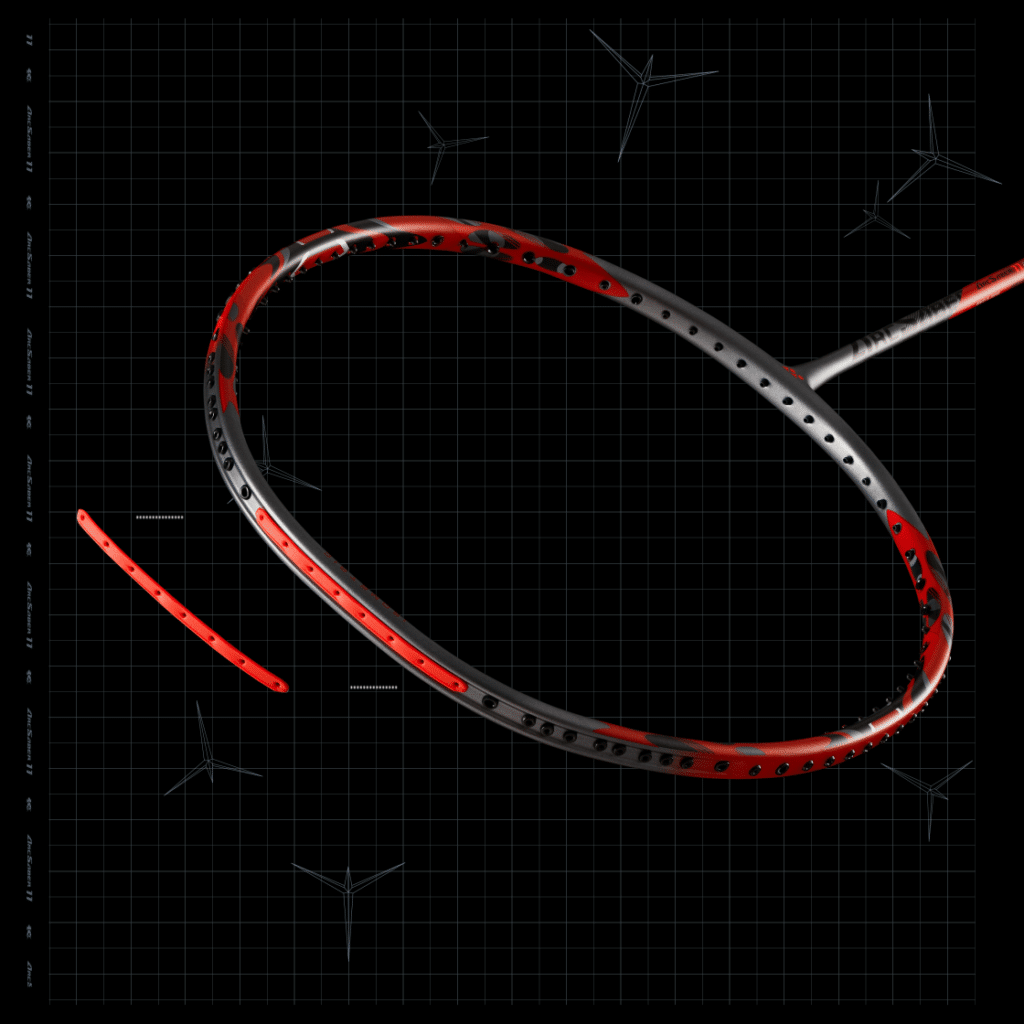
Before diving into the Yonex Arcsaber 11 Play review, let me clear up any confusion between the similar looking models.
Yonex’s Arcsaber 11 Play is the affordable version of the popular Arcsaber 11 Pro, the latest edition of the original Arcsaber 11.
It’s the current flagship racket in the Arcsaber series that enhances your precision rather than power or speed.
The Arcsaber 11 Play is an even balanced racket that falls in the middle of the flex scale and is only available in the lighter 4U weight class often used for doubles games.

For a player like me who’s intermediate, the medium stiffness felt good. Despite my liking for power, it suited me better than the similar Yonex Astrox 77 Play even though that racket is supposed to have more power through its extra head weight.
Table of Contents
Yonex Arcsaber 11 Play review
I’ve played with this racket for about a year and I’m reviewing it with high-beginner and low-intermediate players in mind.
As always, In preparation for this Arcsaber 11 Play review, I got it restrung to Yonex’s BG80 string, which is a power (repulsion) string to keep my reviews consistent between rackets.
I hadn’t played with a control-based badminton racket before getting my hands on this one, so I was intrigued to figure out what exactly shuttle hold feels like and what all the fuss was about as Yonex shows this in their marketing.
Basically, the shuttle hold is the contact point where the shuttle hits the racket. The longer that contact time is, the easier it is to hit precisely and guide the shuttle around the court to outsmart your opponents.
It’s not going to glue the shuttle to your racket and magically turn you into Taufik Hidayat, who famously played with an earlier edition of this racket… unless you believe in magic. Then it just might.
This review is also available on video.
Power
Coming right off of testing the powerful Yonex Astrox 100 Game, I wasn’t expecting much power but I was pleasantly surprised right from the start as lifts and clears were nice and easy without being a complete powerhouse. Not as easy as with the Astrox 100 Game but certainly respectable.
I found that hitting a hard, powerful, smash is possible when your technique is on point but it requires more focus. In comparison, the power rackets make it more effortless, which is useful for those of us who aren’t able to practice our technique as much as we’d like since we’ll inevitably hit off days every now and then.
In an attempt to make this more tangible, I’ll give you an arbitrary number as that can sometimes be easier to understand. It felt as if I was able to hit one meter (roughly one yard) further on a clear, or with 25% more power, when using the powerful Yonex Astrox 100 Game compared to the Arcsaber 11 Play if I didn’t concentrate hard on my technique during the shot (as is often the case if we’re under pressure during a match).
If you’re a beginner or intermediate player, you might not notice the extra power unless you’re pushing your opponent back to the rear court or attempting to overwhelm them with a smash.
On the other hand, the extra push from a powerful racket can be nice if you get tired as your session progresses. It allows you to be later on the shuttle while still being able to whip it back over the net without too much effort since shots just fly longer and bounce easier even with slight touches.
Midcourt and defense
Medium-hard shots like flat drives, shots from the midcourt to the backline, or a late flat drop between the mid- and rear court, felt good.
I found it easy to strike a good balance between control and power, without getting too much and making the follow up easy for the opponent. It was as if I had more firepower in those situations than with the Astrox 77 Play, yet more control than with the Astrox 100 Game.
If you’ve been following the blog for a while you know that I love smash “power” blocks where you just put the racket on and it bounces back nicely. Those felt decent but still required a bit of a whip.
Where highly power-inclined rackets make it easy for the shuttle to bounce back over the net without you barely moving, my experience with the Arcsaber 11 Play was slightly more held back.
I didn’t have to work much more to send the shuttle back over the net but I had a touch more control… or at least it gave me the illusion of control. Either way, it enabled me to adjust the angle slightly and make my follow up more challenging for the opponent. That, even on fairly powerful shots in an awkward angle close to the body where you aren’t able to swing much.
Net play
Net play felt somewhere in the middle in terms of how much power you’d have to apply to get the shuttle over the net and the amount of control.
It was easier than with power-based rackets but still requires plenty of concentration to play accurate tight shots around the net, especially if you’re moving there explosively to defend as it’s easy to give a touch too much power and offer a net kill to an attentive opponent.
On a side note, that cap at the top of the handle felt unusually nice to use compared to other beginner or intermediate rackets I’ve tested thus far.

As if it was smoother and I had a better feeling of where on the handle I was holding through the touch. It gave me more confidence when adjusting my grip from tightly controlled net pressure to a rear court shot that requires holding further down on the racket handle.
Control and shuttle hold
I had heard a lot about the shuttle hold that these Arcsabers are famous for and while I understood what it meant intellectually, I found it hard to truly grasp.
I’d like to tell you that it provided a magic touch that improved my game. But to be honest with you, I struggled to notice the difference in this area compared to other rackets – that could be due to limited skills, though, as other players seem to be able to tell the difference.
My rating here is based on how other players compare the shuttle hold quality relative to that of other rackets as I don’t feel that I can provide a proper and useful assessment here (which also means that if you’re a low-intermediate player, you might not notice it either).
Conclusion
Finally, let me conclude this Arcsaber 11 Play review before diving into the marketing and technology used, who this racket is for and not for along with comparisons against similar rackets you might be interested in.
Overall, I found Yonex’s Arcsaber 11 Play easy to transition to, even when coming from a racket with a different style. As a low-intermediate player, it suited my level well and I had a lot of fun with it.
In fact, this is probably my favorite racket of those I’ve tested thus far.
Hey reader, a quick interruption...
I’m experimenting partnering with webshops that sell badminton gear, like Amazon. I’ll include links to buy the gear I review and if you do, they’ll pay me a small commission. That doesn’t change your price and you’ll get more play-tested gear as a result but I thought it was fair to let you know.
As an Amazon Associate, I earn from qualifying purchases.
I appreciate your support,
Aske
Yonex Arcsaber 11 Play: the verdict

Summary
This is arguably the first time I’ve given a full rating in the value-for-money category.
While this racket isn’t perfect, and it lacks power, it’s terrific at what it’s trying to do and especially when you consider its price point.
Yonex Arcsaber 11 Play’s marketing and technology
The Arcsaber 11 Play is marketed as a high beginner to intermediate racket with focus on control, stability, and a few milliseconds of extra contact time between the shuttle and racket.
Isometric technology
It’s advertised with Isometric technology to create a larger sweet spot making it easier to hit the shuttle cleanly.
As a fun little exercise, I looked at all the rackets Yonex is currently marketing and they all carry that same technology so it’s hardly anything special. At least, if you’re comparing against other Yonex rackets (I guess it’s about time as this technology was developed over 30 years ago).
Box frame
The Box frame is extra stiff to create a solid feel when you hit as some rackets can feel almost whopply. In terms of technologies available, we can look at this as the opposite of Yonex’s Aero frame which is used on their Nanoflare rackets to cut air resistance and create a faster swing.
On top of that, the sides of the frame have been made softer on this racket to allow for more flexibility near the sweet spot.
Control-Assist Bumper
The Control-Assist Bumper is something we only see on the Arcsabers at the time of writing this, and in fact, only on the Arcsaber 11-series.

It’s attached at the very top of the racket to help lock in the strings that go vertically through the racket so as to improve accuracy.
The marketing material does mention other flashy technology like the Pocketing Booster but that is only available on higher end models, not on the Arcsaber 11 Play.
Best player types for Yonex Arcsaber 11 Play
The ideal player type
This is a great racket for the player around the low-intermediate level. It’s suitable if you don’t smash that much or have trained your technique, so you don’t depend on a racket having to be powerful in order to smash hard (provided you like that).
It’s a good fit if you’re an all-around player or someone looking for a racket that isn’t highly specialized in speed or power. If you like gently guiding the shuttle (and your opponents) around the court with precise shots, this is the perfect fit for you.
The Arcsaber 11 Play falls into an interesting niche of players wanting a racket that’s strong across the board, without aiding too much in one area, but requires you to adapt to your opponents and outsmart them.
You might not like this racket if…
This racket isn’t for you if you depend on loads of raw power and smashes to score points as there are other rackets better suited for you out there. It rewards a versatile game over a one-sided one.
This racket also isn’t your best option if you’re looking for something ultra fast, lightweight or soft around the net.
Finally, if you’re just starting out with badminton, this racket might be too stiff for you to take advantage of.
Arcsaber 11 Play compared to other popular rackets
Let’s look at the Arcsaber 11 Play compared to other badminton rackets you might consider.
Yonex Arcsaber 11 Play vs. Arcsaber 11 Pro and Tour
The Arcsaber 11 Play is the most affordable of the Arcsaber 11 rackets.
In the middle, there’s the Tour-version which is slightly more affordable than the Pro but follows a similar set of specs and requires a higher skill level (like the Pro) than the Play to enjoy playing with.
The Play edition I’ve been play-testing in this review is made in China, with cheaper material, and in part, different technology. It’s super affordable at about a third of the price of the Pro, which is made in Japan. The Tour falls somewhere in the middle and is made in Taiwan.
If you’re a more experienced player and ready to pay more for your racket, you’ll be better off considering the Arcsaber 11 Tour or Pro.
Yonex Arcsaber 11 Play vs. Arcsaber 7 Play
I understand that the cousin, Yonex’s Arcsaber 7 Play, is a slightly swifter, lighter and faster version of this racket whereas the Arcsaber 11 Play has a tad more power.
The Arcsaber 7 Play’s more flexible shaft makes it suitable for beginners, whereas the Arcsaber 11 Play is for you if your technique is around the intermediate level.
Yonex Arcsaber 11 Play vs. Astrox 77 Play
The Arcsaber 11 Play looks similar to Yonex’s Astrox 77 Play in the racket matrix. The Astrox 77 Play is more flexible and suited for beginners, yet offers more weight in the head, which should translate into more power.
I say “should” because I found it similar to the Arcsaber 11 Play in being strong across the board with no obvious downsides, but also found that I had to adjust my technique quite a bit to get the full use out of it. I often mistimed my shots with the Astrox 77 Play and at times, I struggled to feel the tad bit extra head power when comparing them directly.
If you’re at the low intermediate level or above, I’d consider the Arcsaber 11 Play, whereas if you’re a beginner you might prefer the Astrox 77 Play.
Arcsaber 11 Play Specifications
| Flex | Medium |
| Balance Point | Even Balance |
| Weight / Grip | 4U G5 |
Recommended strings
| Yonex’s recommended strings | Control Players: N/A Hard Hitters: N/A |
Takeaways
- The Arcsaber 11 Play is a great racket for the intermediate player who likes an all-around game without being too focused on one aspect such as the smash or soft net play
- This racket is strong in most areas but can’t compete in specialized areas often used in singles games
- Open the Arcsaber 11 Play in this catalog I’m experimenting with to get more details about the racket
4 comments
Strangely, Yonex’s official chart showed this racket to be more flexible than your chart. Too bad there isn’t an Arcsaber 11 GAME version for intermediates.
Hmm ……….
https://www.badmintonbay.com/image/data/yonex/technology/2023-ArcSaber-racket-selector.png
Yeah, this racket felt stiffer to me than the head heavy Yonex Astrox 99 Play, which Yonex categorizes as about as stiff (https://issuu.com/yonex-ger/docs/yonex_badminton_katalog_2023_en – page 12-13).
It terms of stiffness, this seemed more like their GAME-model rackets than their PLAY-models.
Noted with thanks! Testers like you and CKYew (on Youtube) give us a better picture of how rackets actually feel compared to the sometimes, inaccurately depicted specs by manufacturers (for the sake of sales or product differentiation, perhaps). For example, Yonex’s supposedly-stiff latest Nanoflare 800 Pro, has been tested by many to be more like mid-flex, more like a “700 Pro” than resembling anything like it’s predecessor, the really stiff 800. CKYew also disagreed with the positioning of various Yonex’s 88S, 88D and 100 rackets on Yonex’s racket chart. Also, my Hi-Flex Astrox Lite 27i feels more mid-flex than at the far-end of flexibility as indicated by Yonex.
With the reviews from you guys, we consumers have a clearer idea of what we are really buying into.
Thanks for the kind words. Yes, that’s the idea – as players, we need a better approach to selecting rackets than dry swinging them at the store